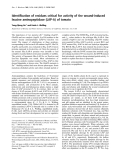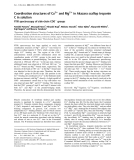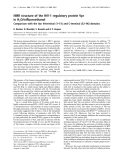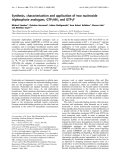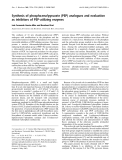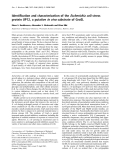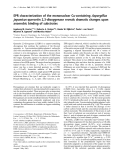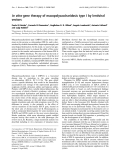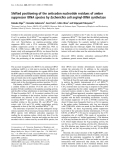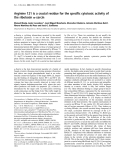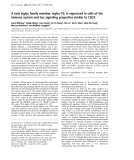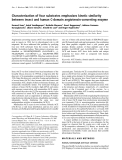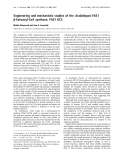
Analysis of cytoplasmic
-
The importance of two putative Zn2+-binding (Asp347, Glu429) and two catalytic (Arg431, Lys354) residues in the tomato leucine aminopeptidase (LAP-A) function was tested. The impact of substitutions at these positions, corresponding to the bovine LAP residues Asp255, Glu334, Arg336, and Lys262, was evaluated in His6–LAP-A fusion proteins expressed in Escherichia coli. Sixty-five percent of the mutant His6–LAP-A proteins were unstable or had complete or partial defects in hexamer assembly or stability. The activity of hexameric His6–LAP-As on Xaa-Leu and Leu-Xaa dipeptides was tested.
 11p
11p  system191
system191
 01-06-2013
01-06-2013
 44
44
 4
4
 Download
Download
-
FTIR spectroscopy has been applied to study the coordination structures of Mg2þ and Ca2þ ions bound in Akazara scallop troponin C (TnC), which contains only a single Ca2þ binding site. The region of the COO – antisymmetric stretch provides information about the coordination modes of COO – groups to the metal ions: bidentate, unidentate, or pseudo-bridging. Two bands were observed at 1584 and 1567 cm21 in the apo state, whereas additional bands were observed at 1543 and 1601 cm21 in the Ca2þ-bound and Mg2þ-bound states, respectively.
 7p
7p  system191
system191
 01-06-2013
01-06-2013
 43
43
 2
2
 Download
Download
-
The human immunodeficiency virus type 1, HIV-1, genome encodes a highly conserved regulatory gene product, Vpr (96 amino acids), which is incorporated into virions in quantities equivalent to those of the viral Gag protein. In infected cells, Vpr is believed to function during the early stages of HIV-1 replication (such as transcription of the proviral genome and migration of preintegration nuclear complex), blocks cells in G2 phase and triggers apoptosis.
 10p
10p  system191
system191
 01-06-2013
01-06-2013
 46
46
 4
4
 Download
Download
-
Amplification of N-myc oncogene is a frequent event in advanced stages of human neuroblastoma and correlates with poor prognosis and enhanced neovascularization. Angiogenesis is an indispensable prerequisite for the progression and metastasis of solid malignancies, which is modulated by tumor suppressors and oncogenes. We have addressed the possibility that N-myc oncogene might regulate angiogenesis in neuroblastoma. Here, we report that experimental N-Myc overexpression results in down-regulation of leukemia inhibitory factor (LIF), a modulator of endothelial cell proliferation....
 10p
10p  system191
system191
 01-06-2013
01-06-2013
 37
37
 4
4
 Download
Download
-
Bacteroides vulgatus has been shown to be involved in the aggravation of colitis. Previously, we separated two potent virulence factors, capsular polysaccharide (CPS) and lipopolysaccharide (LPS), from a clinical isolate of B. vulgatus and characterized the structure of CPS. In this study, we elucidated the structures of O-antigen polysaccharide (OPS) and lipid A in the LPS. LPS was subjected to weak acid hydrolysis to produce the lipid A fraction and polysaccharide fraction.
 7p
7p  system191
system191
 01-06-2013
01-06-2013
 56
56
 8
8
 Download
Download
-
Guanosine triphosphate nucleotide analogues such as GppNHp (also named GMPPNP) or GTPcS are widely used to stabilize rapidly hydrolyzing protein-nucleotide complexes and to investigate biochemical reaction pathways. Here we describe the chemical synthesis of guanosine 5¢-O-(c-amidotriphosphate) (GTPcNH2) and a new synthesis of guanosine 5¢-O-(c-fluorotriphosphate) (GTPcF). The two nucleotides were characterized using NMR spectroscopy and isothermal titration calorimetry. Chemical shift data on 31P, 19F and 1H NMR resonances are tabulated.
 9p
9p  system191
system191
 01-06-2013
01-06-2013
 34
34
 5
5
 Download
Download
-
The synthesis of 10 new phosphoenolpyruvate (PEP) analogues with modifications in the phosphate and the carboxylate function is described. Included are two potential irreversible inhibitors of PEP-utilizing enzymes. One incorporates a reactive chloromethylphosphonate function replacing the phosphate group of PEP. The second contains a chloromethyl group substituting for the carboxylate function of PEP. An improved procedure for the preparation of the known (Z)- and (E)-3-chloro-PEP is also given.
 11p
11p  system191
system191
 01-06-2013
01-06-2013
 37
37
 3
3
 Download
Download
-
Many groups of proteins play important roles in the cell’s response to various stresses. The molecular chaperone GroEL of Escherichia coli represents one such highly conserved family of stress proteins. We have observed that isolated GroEL complexes from stationary cultures contain various polypeptides that can be released from the chaperonin by GroES and/or ATP, and identified two such polypeptides as the proteins GatY and UP12.
 9p
9p  system191
system191
 01-06-2013
01-06-2013
 31
31
 3
3
 Download
Download
-
Quercetin 2,3-dioxygenase (2,3QD) is a copper-containing dioxygenase that catalyses the oxidation of the flavonol quercetin to 2-protocatechuoylphloroglucinol carboxylic acid with concomitant production of carbon monoxide. In contrast to iron dioxygenases, very little is known about copper dioxygenases. We have characterized 2,3QD from the fungus Aspergillus japonicus by electron paramagnetic resonance spectroscopy (EPR). At pH 6.0, 2,3QD shows a mixture of two EPR species. The major form has parameters typical of type 2 Cu sites (g// ¼ 2.330, A// ¼ 13.
 9p
9p  system191
system191
 01-06-2013
01-06-2013
 33
33
 7
7
 Download
Download
-
A series of trehalose-based oligosaccharides were isolated from the cytoplasmic fraction of Mycobacterium smegmatis and purified by gel-filtration and paper chromatography and TLC. Their structures were determined by HPLC and GLC to determine sugar composition and ratios, MALDI-TOF MS to measure molecular mass, methylation analysis to determine linkages, 1H-NMR to obtain anomeric configurations of glycosidic linkages, and exoglycosidase digestions followed by TLC to determine sequences and anomeric configurations of the monosaccharides....
 8p
8p  system191
system191
 01-06-2013
01-06-2013
 36
36
 5
5
 Download
Download
-
Agrobacterium tumefaciens is a Gram-negative, phytopathogenic bacterium and is characterized by an unique mode of action on dicotyledonous plants: it is able to genetically modify the host, and because of this feature, it is used as a tool for transgenic plants. Many experiments have demonstrated that lipopolysaccharides (LPSs) play an important role for the disease development, as they are involved in the adhesion process of the bacterium on the plant cell wall.
 4p
4p  system191
system191
 01-06-2013
01-06-2013
 35
35
 4
4
 Download
Download
-
Mucopolysaccharidosis type I (MPS I) results from a deficiency in the enzyme a-L-iduronidase (IDUA), and is characterized by skeletal abnormalities, hepatosplenomegaly and neurological dysfunction. In this study, we used a late generation lentiviral vector to evaluate the utility of this vector system for the transfer and expression of the human IDUA cDNA in MPS I fibroblasts. We observed that the level of enzyme expression in transduced cells was 1.5-fold the level found in normal cells; the expression persisted for at least two months....
 8p
8p  system191
system191
 01-06-2013
01-06-2013
 35
35
 5
5
 Download
Download
-
Two ORFs, cphA and cphB, encoding proteins CphA and CphB with strong similarities to plant phytochromes and to the cyanobacterial phytochrome Cph1 of Synechocystis sp. PCC 6803 have been identified in the filamentous cyanobacterium Calothrix sp. PCC7601. While CphA carries a cysteine within a highly conserved amino-acid sequence motif, to which the chromophore phytochromobilin is covalently bound in plant phytochromes, in CphB this position is changed into a leucine.
 10p
10p  system191
system191
 01-06-2013
01-06-2013
 44
44
 4
4
 Download
Download
-
Laboratoire des Venins et Toxines, Institut Pasteur de Tunis, Tunisia; 2De´partement d’Inge´nierie et d’Etude des Prote´ines, CEA, Saclay, France; 3UMR 6560, Universite´ de la Me´diterrane´e, CNRS, Inge´nierie des Prote´ines, Laboratoire de Biochimie, IFR Jean-Roche, Faculte´ de Me´decine Nord, Marseille, France; 4Laboratoire de Neurophysiologie UPRES EA 2647, UFR Sciences, Angers, France BotXIV and LqhaIT are two structurally related long chain scorpion a-toxins that inhibit sodium current inactivation in excitable cells.
 11p
11p  system191
system191
 01-06-2013
01-06-2013
 47
47
 4
4
 Download
Download
-
Laboratory for Phytopathology and Plant Protection, Katholieke Universiteit Leuven, Leuven, Belgium; 2Institut de Pharmacologie et ´ Biologie Structurale, Unite Mixte de Recherche Centre National de la Recherche Scientifique 5089, Toulouse, France; 3Institute of Plant Biochemistry, Halle, Germany; 4Laboratory of Developmental Physiology and Molecular Biology, Katholieke Universiteit Leuven, Leuven, Belgium
 11p
11p  system191
system191
 01-06-2013
01-06-2013
 57
57
 5
5
 Download
Download
-
Cytidine in the anticodon second position (position 35) and G or U in position 36 of tRNAArg are required for aminoacylation by arginyl-tRNA synthetase (ArgRS) from Escherichia coli. Nevertheless, an arginine-accepting amber suppressor tRNA with a CUA anticodon (FTOR1D26) exhibits suppression activity in vivo [McClain, W.H. & Foss, K. (1988) Science, 241, 1804 –1807]. By an in vitro kinetic study with mutagenized tRNAs, we showed that the arginylation of FTOR1D26 involves C34 and U35, and that U35 can be replaced by G without affecting the activity.
 7p
7p  system191
system191
 01-06-2013
01-06-2013
 24
24
 3
3
 Download
Download
-
a-Sarcin, a cyclizing ribonuclease secreted by the mould Aspergillus giganteus, is one of the best characterized members of a family of fungal ribotoxins. This protein induces apoptosis in tumour cells due to its highly specific activity on ribosomes. Fungal ribotoxins display a threedimensional protein fold similar to those of a larger group of microbial noncytotoxic RNases, represented by RNases T1 and U2.
 7p
7p  system191
system191
 01-06-2013
01-06-2013
 27
27
 3
3
 Download
Download
-
The siglecs (sialic acid-binding Ig-like lectins) are a distinct subset of the Ig superfamily with adhesion-molecule-like structure. We describe here a novel member of the siglec protein family that shares a similar structure including five Ig-like domains, a transmembrane domain, and a cytoplasmic tail containing two ITIM-signaling motifs. Siglec10 was identified through database mining of an asthmatic eosinophil EST library. Using the Stanford G3 radiation hybrid panel we were able to localize the genomic sequence of siglec-10 within the cluster of genes on chromosome 19q13.
 14p
14p  system191
system191
 01-06-2013
01-06-2013
 45
45
 6
6
 Download
Download
-
Angiotensin converting enzyme (ACE) was already discovered in insects in 1994, but its physiological role is still enigmatic. We have addressed this problem by purifying four new ACE substrates from the ovaries of the grey fleshfly, Neobellieria bullata. Their primary structures were identified as NKLKPSQWISLSD (Neb-ODAIF-11)13), NKLKPSQWI (Neb-ODAIF-11)9), SLKPSNWLTPSE (Neb-ODAIF-2) and LEQIYHL. Database analysis showed significant homology with amino acid sequence stretches as present in the N-terminal part of several fly yolk proteins....
 9p
9p  research12
research12
 01-06-2013
01-06-2013
 37
37
 3
3
 Download
Download
-
The Arabidopsis FAE1 b-ketoacyl-CoA synthase (FAE1 KCS) catalyzes the condensation of malonyl-CoA with longchain acyl-CoAs. Sequence analysis of FAE1 KCS predicted that this condensing enzyme is anchored to a membrane by two adjacent N-terminal membrane-spanning domains. In order to characterize the FAE1 KCS and analyze its mechanism, FAE1 KCS and its mutants were engineered with a His6-tag at their N-terminus, and expressed in Saccharomyces cerevisiae. The membrane-bound enzyme was then solubilized and purified to near homogeneity on a metal affinity column.
 9p
9p  research12
research12
 01-06-2013
01-06-2013
 48
48
 3
3
 Download
Download
CHỦ ĐỀ BẠN MUỐN TÌM









